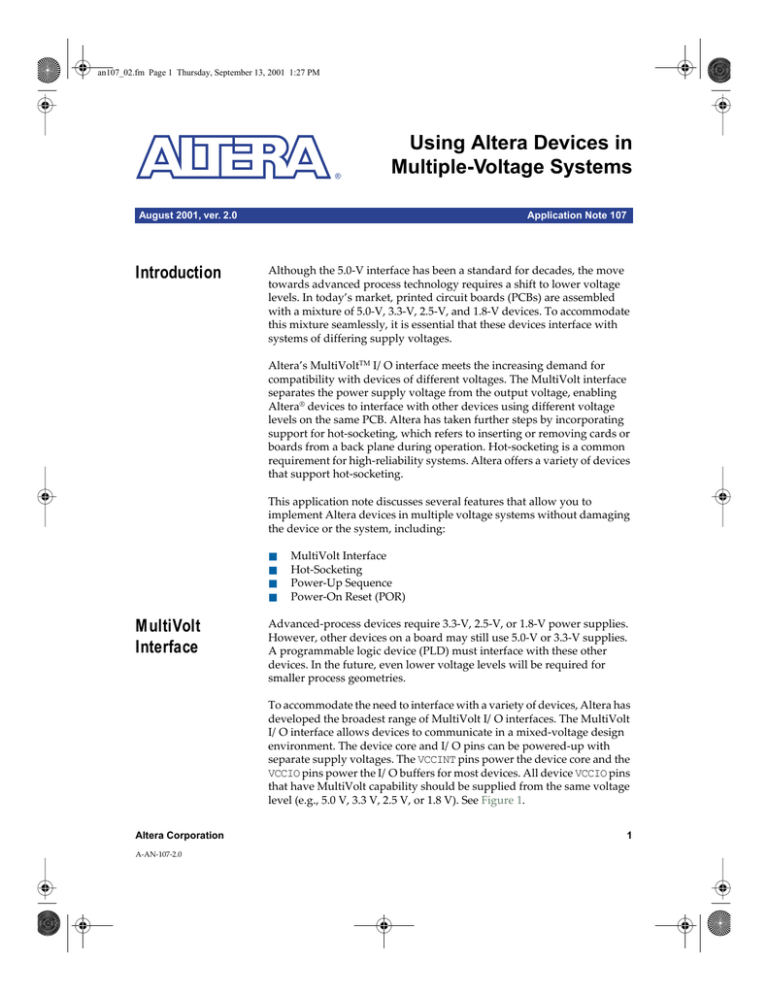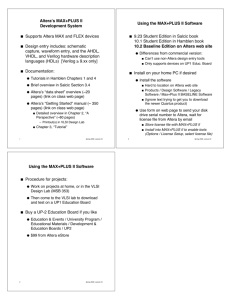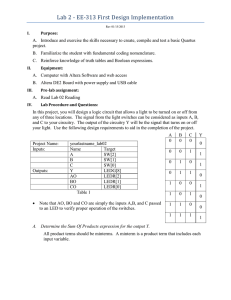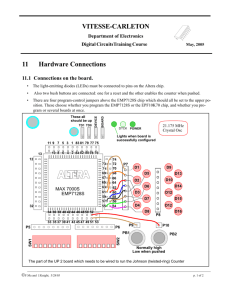
an107_02.fm Page 1 Thursday, September 13, 2001 1:27 PM
®
Using Altera Devices in
Multiple-Voltage Systems
August 2001, ver. 2.0
Introduction
Application Note 107
Although the 5.0-V interface has been a standard for decades, the move
towards advanced process technology requires a shift to lower voltage
levels. In today’s market, printed circuit boards (PCBs) are assembled
with a mixture of 5.0-V, 3.3-V, 2.5-V, and 1.8-V devices. To accommodate
this mixture seamlessly, it is essential that these devices interface with
systems of differing supply voltages.
Altera’s MultiVoltTM I/O interface meets the increasing demand for
compatibility with devices of different voltages. The MultiVolt interface
separates the power supply voltage from the output voltage, enabling
Altera® devices to interface with other devices using different voltage
levels on the same PCB. Altera has taken further steps by incorporating
support for hot-socketing, which refers to inserting or removing cards or
boards from a back plane during operation. Hot-socketing is a common
requirement for high-reliability systems. Altera offers a variety of devices
that support hot-socketing.
This application note discusses several features that allow you to
implement Altera devices in multiple voltage systems without damaging
the device or the system, including:
■
■
■
■
MultiVolt
Interface
MultiVolt Interface
Hot-Socketing
Power-Up Sequence
Power-On Reset (POR)
Advanced-process devices require 3.3-V, 2.5-V, or 1.8-V power supplies.
However, other devices on a board may still use 5.0-V or 3.3-V supplies.
A programmable logic device (PLD) must interface with these other
devices. In the future, even lower voltage levels will be required for
smaller process geometries.
To accommodate the need to interface with a variety of devices, Altera has
developed the broadest range of MultiVolt I/O interfaces. The MultiVolt
I/O interface allows devices to communicate in a mixed-voltage design
environment. The device core and I/O pins can be powered-up with
separate supply voltages. The VCCINT pins power the device core and the
VCCIO pins power the I/O buffers for most devices. All device VCCIO pins
that have MultiVolt capability should be supplied from the same voltage
level (e.g., 5.0 V, 3.3 V, 2.5 V, or 1.8 V). See Figure 1.
Altera Corporation
A-AN-107-2.0
1
an107_02.fm Page 2 Thursday, September 13, 2001 1:27 PM
Using Altera Devices in Multiple-Voltage Systems
Figure 1. MultiVolt I/O Interface Feature for Altera Devices
5.0-V
Device
Altera
Device
Note (1)
3.3-V
Device
2.5-V
Device
Note to Figure 1:
(1)
The Altera device can interact with each voltage one at a time, but not
simultaneously (except APEXTM 20KE and MAX® 7000B devices, which can have
different VCCIO levels simultaneously).
5.0-V Device Compatibility
5.0-V devices—FLEX® 10K, MAX 9000, MAX 7000S, MAX 7000,
FLEX 8000, and 5.0-V FLEX 6000 devices—support interfaces to 3.3-V and
5.0-V devices.
3.3-V Device Compatibility
When using 3.3-V devices—FLEX 10KA, 3.3-V FLEX 6000, MAX 7000A,
and MAX 3000A devices—the VCCINT pins must be connected to a 3.3-V
power supply. The VCCIO pins can be connected to either a 2.5-V or 3.3-V
power supply, depending on the output requirements. When the VCCIO
pins are connected to a 3.3-V power supply, the output high is 3.3 V and
is therefore compatible with 3.3-V or 5.0-V systems. The device can also
drive other 3.3-V tolerant, 2.5-V devices. Inputs for the above devices can
always be driven by 2.5-V, 3.3-V, or 5.0-V systems, except for EPF10K50V
and EPF10K130V devices, which can only be driven by 3.3-V and 5.0-V
systems.
2
Altera Corporation
an107_02.fm Page 3 Thursday, September 13, 2001 1:27 PM
Using Altera Devices in Multiple-Voltage Systems
2.5-V Device Compatibility
The VCCINT pins on 2.5-V APEX 20K, ACEXTM 1K, FLEX 10KE, and
MAX 7000B devices must be connected to a 2.5-V power supply. The
VCCIO pins can be connected to either a 2.5-V or 3.3-V power supply,
depending on the output requirements. When the VCCIO pins are
connected to a 2.5-V power supply, the output levels are compatible with
2.5-V systems. When the VCCIO pins are connected to a 3.3-V power
supply, the output high is 3.3 V and is therefore compatible with 3.3-V or
5.0-V systems. The device can also drive other 3.3-V tolerant, 2.5-V
devices.
1
The APEX 20K device family incorporates a wider variety of I/O
standards. This device family is covered in Application Note 117
(Using Selectable I/O Standards in Altera Devices).
Table 1 summarizes Altera MultiVolt I/O support.
Table 1. Altera MultiVolt I/O Support
Device
VCCINT
(V)
VCCIO
(V)
FLEX 10K,
FLEX 8000,
FLEX 6000 (5.0 V),
MAX 7000S,
MAX 9000
5.0
EPF10K50V,
EPF10K130V
Notes (1), (2)
Input Signal (V)
3.3
5.0
5.0
v
v
3.3
v
3.3
3.3
FLEX 10KA,
FLEX 6000 (3.3 V),
MAX 7000A,
MAX 3000A
3.3
3.3
2.5
FLEX 10KE
2.5
ACEX 1K
APEX 20K (3)
APEX 20KE (3), (4)
MAX 7000B
Altera Corporation
2.5
2.5
1.8
2.5
3.3
5.0
v
v
v
v
v
v
v
v
v
v
v
v
v
v
v
3.3
v
v
v
v
v
2.5
v
v
v
3.3
v
v
v
v
v
2.5
v
v
v
3.3
v
v
2.5
v
v
v
v
3.3
1.8
v
2.5
Output Signal (V)
2.5
v
v
v
1.8
v
v
v
3.3
v
v
v
2.5
v
v
v
1.8
v
v
v
1.8
2.5
v
v
v
v
v
v
v
v
v
v
v
v
3
an107_02.fm Page 4 Thursday, September 13, 2001 1:27 PM
Using Altera Devices in Multiple-Voltage Systems
Notes to Table 1:
(1)
(2)
(3)
(4)
All FLEX 10K devices support 3.3-V I/O pins with a 5.0-V core, except 84-pin plastic J-lead chip carrier (PLCC) and 240-pin
quad flat pack (QFP) packages. All MAX 7000S devices—except EPM7032S and EPM7064S devices in the 44-pin PLCC and
thin quad flat pack (TQFP) packages—support 3.3-V I/O pins with a 5.0-V core.
The EPF8282V I/O pins are not 5.0-V tolerant. Altera does not recommend driving 5.0-V signals to these 3.3-V devices.
APEX 20K and APEX 20KE I/O pins are not 5.0-V tolerant.
For more information on APEX 20KE MultiVolt support, see Application Note 117 (Using Selectable I/O Standards in Altera
Devices).
5.0-V TTL Compatibility
Altera 5.0-V tolerant devices are 5.0-V TTL compatible. For example, a
3.3-V device can drive a 5.0-V device, and in return, can be driven by a
5.0-V device. Additionally, when the VCCIO pins on a 5.0-V device are
connected to 3.3 V, the I/O pins can still be driven by 5.0-V signals
because the I/O buffers are still 5.0-V tolerant.
5.0-V CMOS Compatibility
Altera’s 5.0-V devices with NMOS-only output buffers meet 5.0-V TTL
levels. When the voltage at the output pin exceeds approximately
3.8 V, the NMOS pull-up transistor goes to cut-off mode. Therefore, you
can use an external pull-up resistor to pull up the signal to 5.0 V. See
Figure 2.
Figure 2. 5.0-V Altera Device Compatibility with 5.0-V CMOS Devices Note (1)
VCCIO = 5.0 V or 3.3 V
V1
REXT
M1
VOUT
V2
5.0 V
5.0-V CMOS
Device
M2
VSS
Note to Figure 2:
(1)
4
When VOUT ≥ 3.8 V, transistor M1 is cut-off. As a result, the external resistor (REXT)
can pull up the output node (VOUT) to a full rail level of 5.0 V.
Altera Corporation
an107_02.fm Page 5 Thursday, September 13, 2001 1:27 PM
Using Altera Devices in Multiple-Voltage Systems
To make Altera low-voltage device outputs compatible with 5.0-V CMOS
devices, configure the output pins as open-drain pins and use an external
pull-up resistor. The low-voltage devices have a CMOS driver; if VOUT >
VCCIO, the PMOS pull-up transistor still conducts if the pin is driving
high, preventing an external pull-up resistor from pulling the signal to
5.0 V (see Figure 3). 5.0-V tolerant, 3.3-V and 2.5-V devices can also drive
5.0-V CMOS devices.
Figure 3. CMOS Output Buffer for Altera Low-Voltage Devices
VCCIO = 3.3 V or 2.5 V
I
V1
VOUT
Note (1)
5.0 V
REXT
5.0-V CMOS
Device
V2
VSS
Note to Figure 3:
(1)
When VOUT > VCCIO, the current will flow as shown above. As a result, the VOUT
node cannot be pulled to 5.0 V.
To pull the output of a low-voltage device up to the VIH (input high) level
of a 5.0-V CMOS device, use an open-drain pin driving a trace that is
pulled up to 5.0 V through an external pull-up resistor (see Figure 4).
Choose a pull-up resistor that is small enough for a sufficient signal rise
time, but large enough that it does not violate the IOL (output low)
specifications of devices driving that trace.
Altera Corporation
5
an107_02.fm Page 6 Thursday, September 13, 2001 1:27 PM
Using Altera Devices in Multiple-Voltage Systems
Figure 4. Low-Voltage Altera Device Compatibility with 5.0-V CMOS
Devices
Note (1)
VCCIO
5.0 V
Open Drain
REXT
VOUT
5.0-V CMOS
Device
VIN
VSS
Note to Figure 4:
(1)
To pull the VOUT to the rail of 5.0 V, ensure that the output is an open drain.
Therefore, the external pull-up resistor (REXT) pulls VOUT to 5.0 V.
The open-drain pin never drives high, only low or tri-state. When the
open-drain pin is active, it drives low. When the open-drain pin is
inactive, the pin is tri-stated and the trace pulls up to 5.0 V by the external
resistor. The device operates successfully because a 5.0-V input is within
its input specification.
Hot-Socketing
Hot-socketing, hot-swap, or hot plug-in refers to inserting or removing a
board or device into or out of a system board while system power is on.
For a system to support hot-socketing, plug-in or removal of a board must
not damage the system or interrupt system operation.
Hot-Socketing in Altera Devices
The following Altera 3.3-V, 2.5-V, 1.8-Vand 1.8-5 devices are designed to
support hot-socketing without special design requirements:
■
■
■
■
■
■
■
■
■
■
6
MercuryTM
APEXTM II
APEX 20K
ACEX 1K
FLEX 10KA
FLEX 10KE (except EPF10K100B devices)
3.3-V FLEX 6000
MAX® 7000AE
MAX 7000B
MAX 3000A
Altera Corporation
an107_02.fm Page 7 Thursday, September 13, 2001 1:27 PM
Using Altera Devices in Multiple-Voltage Systems
The following features have been implemented in Altera devices to ease
the hot-socketing process:
■
■
■
Devices can be driven before power-up with no damage to the device.
Devices do not drive out before or during power-up.
Signal pins do not drive the VCCIO or VCCINT power supplies.
Devices Can Be Driven before Power-Up
Devices that do not support hot-socketing may be damaged if the pins are
driven before the device is powered-up. For Altera devices that support
hot-socketing, the device I/O pins, dedicated input pins, and dedicated
clock pins can be driven before or during power-up without damaging the
device.
Devices Do Not Drive Out before or during Power-Up
Devices that do not support hot-socketing may interrupt system
operation or cause contention by driving out before or during power-up.
In Altera devices that support hot-socketing, I/O pins are tri-stated before
and during power-up and configuration, and will not drive out.
Signal Pins Cannot Drive the V
CCIO
or V CCINT Power Supply
Devices that do not support hot-socketing may be powered-up through
their signal pins (when plugged into a live board) causing the power
supplies to short-out. This irregular power-up can damage both the
driving and driven devices and can disrupt card power-up.
For Altera devices that support hot-socketing, there is no current path
from the I/O, dedicated input, or dedicated clock pins to the VCCIO or
VCCINT pins before and during power-up; therefore, these devices cannot
be powered-up through the I/O pins. Some Altera devices have weak
pull-up resistors; these resistors are activated as the device is powered by
the VCCIO and VCCINT pins. As a result, Altera devices that support hotsocketing may be inserted into (or removed from) a powered-up system
board without damage or without interfering with the operation of the
system board. During hot-socketing, these devices will not affect signal
integrity of the back plane.
Altera Corporation
7
an107_02.fm Page 8 Thursday, September 13, 2001 1:27 PM
Using Altera Devices in Multiple-Voltage Systems
The DC operating conditions in each device data sheet specify the device
input leakage current. For most devices, this leakage current is 10 µA.
During hot-socketing, DC leakage current into an I/O pin may be higher.
Table 2 shows this value for Altera devices that support hot-socketing.
Table 2. Hot-Socket DC Leakage Current for Altera Devices
Device
Condition
Max
Unit
ACEX 1K
FLEX 10KA,
FLEX 10KE,
FLEX 6000 (3.3 V)
VCC = 0 V
VIN ≤ 5.75 V (1)
300 (2)
µA
MAX 7000AE,
MAX 3000A
VCC = 0 V
VIN ≤ 3.6 V (3)
300 (2)
µA
VCC = 0 V
VIN ≤ 5.75 V (1), (4)
300 (2)
µA
VCC = 0 V
VIN ≤ 4.1 V (5)
300 (2)
µA
APEX 20K
MAX 7000B
Notes to Table 2:
(1)
(2)
(3)
(4)
(5)
These devices are 5.0-V tolerant.
Includes current from the weak pull-up resistors in the I/O cell.
The OE1 and GCLRn pins in MAX 7000AE and MAX 3000A devices may be driven
up to 3.6 V during hot-socketing. After VCCINT and VCCIO reach the
recommended operating conditions, these pins are 5.0-V tolerant.
All other pins in MAX 700AE and MAX 3000A devices may be driven up to 5.75 V
during hot-socketing.
These 2.5-V devices are 3.3-V tolerant.
A possible concern regarding hot-socketing is the potential for latch-up.
Latch-up can occur when electrical subsystems are hot-socketed into an
active system. During hot-socketing, the signal pins may be connected
and driven by the active system before the power supply can provide
current to the device’s VCC and ground planes. This condition can lead to
latch-up and cause a low-impedance path from VCC to ground within the
device. As a result, the device expends a large amount of current, possibly
causing electrical damage. All Altera devices are immune to latch-up
when operated within device specifications, including hot-socketing.
Power-Up
Sequence
8
Altera devices are designed to operate in multiple-voltage environments
where it may be difficult to control power sequencing. Therefore, the
devices are designed to accommodate any possible power-up sequence.
The following sections address the power-up sequence for different
voltage levels.
Altera Corporation
an107_02.fm Page 9 Thursday, September 13, 2001 1:27 PM
Using Altera Devices in Multiple-Voltage Systems
When VCCIO and VCCINT are supplied from different power sources to an
Altera device, a delay between VCCIO and VCCINT may occur. Normal
operation does not occur until both power supplies are in their
recommended operating range.
When VCCINT is powered-up, the IEEE Std. 1149.1 Joint Test Action Group
(JTAG) circuitry is active. If TMS and TCK are connected to VCCIO and
VCCIO is not powered-up, the JTAG signals are left floating. Thus, any
transition on TCK can cause the state machine to transition to an unknown
JTAG state, leading to incorrect operation when VCCIO is finally poweredup. To disable the JTAG state during the power-up sequence, TCK should
be pulled low to ensure that an inadvertent rising edge does not occur on
TCK.
f
For more information, refer to Application Note 100 (In-System
Programmability Guidelines).
3.3-V, 2.5-V, or 1.8-V APEX, FLEX & MAX Devices
Because APEX 20K, ACEX 1K, FLEX 10KA, FLEX 10KE,
MAX 7000B, 3.3-V FLEX 6000, MAX 7000AE, and MAX 3000A devices can
be used in a multi-voltage environment, they are designed specifically to
tolerate any possible power-up sequence (where appropriate). VCCINT
and VCCIO can supply power in either sequence. 5.0-V, 3.3-V, 2.5-V, or
1.8-V input signals can drive these devices before VCCINT or VCCIO is
applied without special precautions; the only exception is that the OE1 and
nGCLR pins on MAX 7000AE and MAX 3000A devices must not exceed
3.6 V until VCCIO and VCCINT reach the recommended operating level.
You can change the VCCIO supply voltage from 3.3 V to 2.5 V or vice-versa
while the board is powered-up. However, you must ensure that the
VCCINT and VCCIO power supplies stay within the correct device
operating conditions.
FLEX and configuration devices can power-up in either order, but you
must ensure that the nSTATUS and CONF_DONE pull-up resistors are
connected to the same voltage as the configuration device. This
connection avoids driving signals into a configuration device that is not
powered.
2.5-V and 1.8-V devices are the only Altera devices that can have a VCCIO
voltage level higher than the VCCINT level.
Altera Corporation
9
an107_02.fm Page 10 Thursday, September 13, 2001 1:27 PM
Using Altera Devices in Multiple-Voltage Systems
5.0-V FLEX & MAX Devices
When VCCIO powers-up, MAX devices can drive out without the core
being powered-up. This power-up sequence does not damage MAX
devices and their functionality is not affected, but it may interfere with the
function of the system that contains MAX devices.
Because of possible interference with system functionality, Altera does
not recommend driving 5.0-V MAX device input signals or relying on the
output of the device before VCCINT is powered-up.
FLEX and configuration devices can power-up in either order, but you
must ensure that the nSTATUS and CONF_DONE pull-up resistors are
connected to the same voltage as the configuration device. This
connection avoids driving signals into a configuration device that is not
powered.
Power-On
Reset
The state of a system at power-up is an important consideration in
designing a circuit. When power is applied to an Altera device, the POR
event occurs only if VCC reaches the recommended operating range
within a certain period of time (specified as a maximum VCC rise time). A
POR event does not occur if these conditions are not met because slower
rise times can cause incorrect device initialization and functional failure.
The maximum VCC rise time for FLEX 10K, FLEX 8000, and
FLEX 6000 devices is 100 ms and should be monotonic (during VCC rise
time, the slope is zero or positive). For MAX devices, the maximum VCC
rise time is infinite as long as it is monotonic.
Altera’s device registers are cleared or set (MAX 7000AE, MAX 7000B, and
MAX 3000A devices) during power-on reset. If you are using the
NOT-Gate Push-Back option in the QuartusTM and MAX+PLUS® II
software, the registers power-up active-high. The NOT-Gate Push-Back
option is an advanced logic synthesis option, which allows the compiler’s
logic synthesizer module to push an inversion (i.e., a NOT gate) back
through a register and implement it on that register’s D input.
Once the VCCINT power supply reaches the specified operating range, it
must remain at that range. If VCCINT does not remain in the range, the
operation is not guaranteed until VCCINT re-enters the specified operating
range.
10
Altera Corporation
an107_02.fm Page 11 Thursday, September 13, 2001 1:27 PM
Using Altera Devices in Multiple-Voltage Systems
APEX, ACEX & FLEX Devices
Before the VCC supply reaches the recommended operating range, the
I/O pins are tri-stated, with the exception of APEX 20K, ACEX 1K, and
FLEX 10KE devices that have pull-up resistors at the I/O pins. During
POR, the registers are cleared and the tri-state is released. Once the VCC
power supply reaches a stable and reliable operating voltage and after
nCONFIG has gone high, the actual device configuration begins. During
configuration, the I/O pins are tri-stated.
MAX Devices
Before the VCC supply reaches the recommended operating range for
MAX 7000AE, MAX 7000B, and MAX 3000A devices, the I/O pins are tristated. During POR, the registers are cleared or set. After POR, the tri-state
is released and the I/O pins are in user mode and function as
programmed (if the device has been previously programmed
successfully).
For other MAX 7000—including MAX 7000E, MAX 7000S, and
MAX 7000A—and MAX 9000 devices, the I/O pins are undefined until
VCC reaches the recommended operating range. During POR, the
registers are cleared and the tri-state is released. After POR, the I/O pins
are in user mode and function as programmed.
1
The power-up state of latches is undefined in all Altera devices
except MAX 5000 devices. In MAX 5000 devices, latches
power-up low.
During POR, the device configures I/O pins, clears device registers, and
releases tri-states.
Conclusion
Altera Corporation
PCBs often contain a mix of 5.0-V, 3.3-V, 2.5-V, and 1.8-V devices. The
MultiVolt interface enables the device core to run at a specific voltage
(5.0 V, 3.3 V, 2.5 V, or 1.8 V), while keeping the I/O pins compatible with
5.0-V, 3.3-V, 2.5-V, or 1.8-V logic levels. Altera’s MultiVolt interface allows
you to incorporate newer generation devices with devices of varying
voltage levels seamlessly. Altera has taken further steps by designing
devices which allow VCCINT and VCCIO to power-up in either sequence
and by incorporating support for hot-socketing.
11
an107_02.fm Page 12 Thursday, September 13, 2001 1:27 PM
Using Altera Devices in Multiple-Voltage Systems
101 Innovation Drive
San Jose, CA 95134
(408) 544-7000
http://www.altera.com
Applications Hotline:
(800) 800-EPLD
Customer Marketing:
(408) 544-7104
Literature Services:
lit_req@altera.com
12
Altera and specific device designations are trademarks and/or service marks of Altera Corporation in the
United States and other countries. Altera acknowledges the trademarks of other organizations for their
respective products or services mentioned in this document. Altera products are protected under numerous
U.S. and foreign patents and pending applications, maskwork rights, and copyrights. Altera warrants
performance of its semiconductor products to current specifications in accordance with Altera’s standard
warranty, but reserves the right to make changes to any products and services at any time without notice.
Altera assumes no responsibility or liability arising out of the application or use of any
information, product, or service described herein except as expressly agreed to in writing
by Altera Corporation. Altera customers are advised to obtain the latest version of device
specifications before relying on any published information and before placing orders for
products or services.
Copyright 2001 Altera Corporation. All rights reserved.
Altera Corporation
Printed on Recycled Paper.






